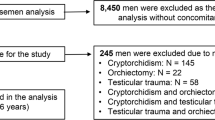Abstract
Purpose
In humans, recent studies have correlated anogenital distance (AGD) in adult men to testicular function. While studies of a group of men suggest an association, the utility of AGD in an infertility evaluation remains uncertain. We sought to determine the utility of AGD to predict male fertility.
Methods
Between 2010 and 2011, men were recruited at a urology clinic to participate. AGD was measured using digital calipers in men being evaluated at a urology clinic. ANOVA and ROC analyses were used to determine correlations between AGD, fatherhood status, and semen parameters.
Results
In all, 473 men were included in the analysis with a mean age of 43 ± 13 years. Anogenital distance was significantly longer in men with higher sperm concentration, total sperm count, and total motile sperm count. In order to evaluate the discriminating ability of AGD, ROC curves were created comparing AGD and total testis volume. The area under the curve (AUC) was significantly larger for total testis volume compared to AGD when evaluating fertility (0.71 vs 0.63, p = 0.02). Similarly, there was a trend towards a higher AUC for testis volume compared to AGD for sperm concentration and total sperm count. Stratification of men with long/short AGD and large/small testes also did not improve the predictive value of AGD.
Conclusions
While AGD is associated with sperm production on a population level, at the individual level the distinction based AGD alone cannot accurately estimate the efficiency of spermatogenesis.

Similar content being viewed by others
References
Greenham LW, Greenham V. Sexing mouse pups. Lab Anim. 1977;11:181–4.
Hsieh MH, Breyer BN, Eisenberg ML, Baskin LS. Associations among hypospadias, cryptorchidism, anogenital distance, and endocrine disruption. Curr Urol Rep. 2008;9:137–42.
Marois G. [Action of progesterone, testosterone and estradiol on the anogenital distance and somatic sexual differentiation in rats]. Biol Med (Paris) 1968;57:44–90.
Thankamony A, Ong KK, Dunger DB, Acerini CL, Hughes IA. Anogenital distance from birth to 2 years: a population study. Environ Health Perspect. 2009;117:1786–90.
Torres-Sanchez L, Zepeda M, Cebrian ME, Belkind-Gerson J, Garcia-Hernandez RM, Belkind-Valdovinos U, et al. Dichlorodiphenyldichloroethylene exposure during the first trimester of pregnancy alters the anal position in male infants. Ann N Y Acad Sci. 2008;1140:155–62.
Salazar-Martinez E, Romano-Riquer P, Yanez-Marquez E, Longnecker MP, Hernandez-Avila M. Anogenital distance in human male and female newborns: a descriptive, cross-sectional study. Environ Health. 2004;3:8.
Sathyanarayana S, Beard L, Zhou C, Grady R. Measurement and correlates of ano-genital distance in healthy, newborn infants. Int J Androl. 2010;33:317–23.
Eisenberg ML, Hsieh MH, Walters RC, Krasnow R, Lipshultz LI. The relationship between anogenital distance, fatherhood, and fertility in adult men. PLoS One. 2011;6:e18973.
Mendiola J, Stahlhut RW, Jorgensen N, Liu F, Swan SH. Shorter anogenital distance predicts poorer semen quality in young Men in rochester, New york. Environ Health Perspect. 2011;119:958–63.
Eisenberg ML, Jensen TK, Walters RC, Skakkebaek NE, Lipshultz LI. The relationship between anogenital distance and reproductive hormone levels in adult men. J Urol. 2012;187:594–8.
Eisenberg ML, Hsieh TC, Lipshultz LI. The relationship between anogenital distance and age. Andrology. 2013;1:90–3.
Eisenberg ML, Shy M, Chanc Walters R, Lipshultz LI. The relationship between anogenital distance and azoospermia in adult men. Int J Androl. 2012;35:726–30.
Eisenberg ML, Shy M, Herder D, Walters RC, Lipshultz LI. The relationship between anogenital distance and the efficacy of varicocele repair. BJU Int. 2012;110:E927–30.
Castano-Vinyals G, Carrasco E, Lorente JA, Sabate Y, Cirac-Claveras J, Pollan M, et al. Anogenital distance and the risk of prostate cancer. BJU Int. 2012;110:E707–10.
Dean A, Sharpe RM. Clinical review: Anogenital distance or digit length ratio as measures of fetal androgen exposure: relationship to male reproductive development and its disorders. The Journal of Clinical Endocrinology and Metabolism. 2013;98:2230–8.
Behre HM, Nashan D, Nieschlag E. Objective measurement of testicular volume by ultrasonography: evaluation of the technique and comparison with orchidometer estimates. Int J Androl. 1989;12:395–403.
Cooper TG, Noonan E, von Eckardstein S, Auger J, Baker HW, Behre HM, et al. World Health Organization reference values for human semen characteristics. Hum Reprod Update. 2010;16:231–45.
DeLong ER, DeLong DM, Clarke-Pearson DL. Comparing the areas under two or more correlated receiver operating characteristic curves: a nonparametric approach. Biometrics. 1988;44:837–45.
Vittinghoff E, Glidden DV, Shiboski SC, McCulloch CE. Regression Methods in Biostatistics: Linear, Logistic, Survival, and Repeated Measures Models. New York: Springer; 2005.
Larson WJ. Human Embryology. 2nd ed. New York: Churchill Livingstone; 1997.
Callegari C, Everett S, Ross M, Brasel JA. Anogenital ratio: measure of fetal virilization in premature and full-term newborn infants. J Pediatr. 1987;111:240–3.
Macleod DJ, Sharpe RM, Welsh M, Fisken M, Scott HM, Hutchison GR, et al. Androgen action in the masculinization programming window and development of male reproductive organs. Int J Androl. 2010;33:279–87.
Welsh M, MacLeod DJ, Walker M, Smith LB, Sharpe RM. Critical androgen-sensitive periods of rat penis and clitoris development. Int J Androl. 2010;33:e144–52.
Moss JL, Crosnoe LE, Kim ED. Effect of rejuvenation hormones on spermatogenesis. Fertil Steril. 2013;99:1814–20.
Mitchell RT, Mungall W, McKinnell C, Sharpe RM, Cruickshanks L, Milne L et al. Anogenital distance (AGD) plasticity in adulthood: Implications for its use as a biomarker of fetal androgen action. Endocrinology 2014:en20141534.
Conflicts of interest
The authors have no conflicts of interest to disclose.
Author information
Authors and Affiliations
Corresponding author
Additional information
Capsule
In humans, recent studies have correlated anogenital distance (AGD) in adult men to testicular function. While AGD is associated with sperm production on a population level, at the individual level the distinction based AGD alone cannot accurately estimate the efficiency of spermatogenesis.
Rights and permissions
About this article
Cite this article
Eisenberg, M.L., Lipshultz, L.I. Anogenital distance as a measure of human male fertility. J Assist Reprod Genet 32, 479–484 (2015). https://doi.org/10.1007/s10815-014-0410-1
Received:
Accepted:
Published:
Issue Date:
DOI: https://doi.org/10.1007/s10815-014-0410-1




